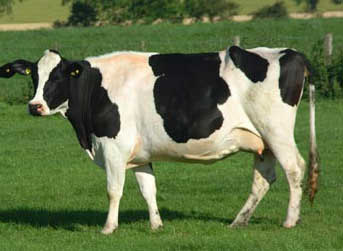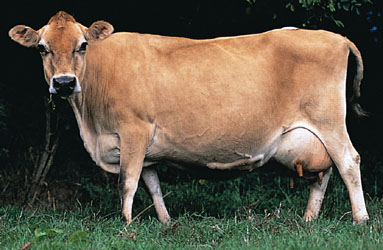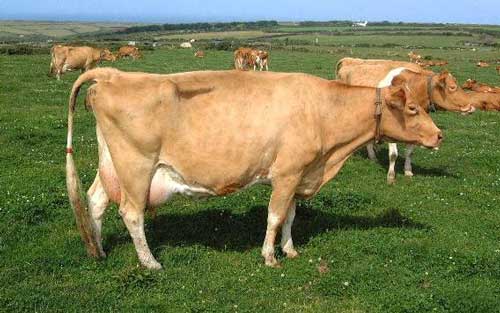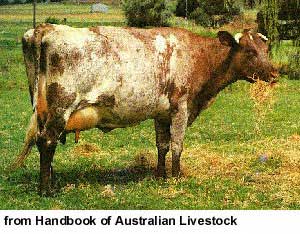Dairying is a major Australian agricultural industry. The estimate of the gross value of dairy production at farm gate prices in 1999-2000 was $2.8b. This represented 9% of the gross value of agricultural production in Australia and placed dairy production third behind beef and wheat. The number of milk cattle in 2000 was 3.1 million, 2% less than in 1999.
The entry of the United Kingdom, Australia's then largest market, into the European Union in 1973 forced the Australian dairy industry to become more internationally competitive and to develop new export trade links.
DAIRY PRODUCTION
Most dairy production occurs in high rainfall coastal fringe areas where climate and natural resources allow production to be based on year-round pasture grazing. This encourages efficient, low cost milk production. With the exception of several inland river schemes, pasture growth generally depends on natural rainfall. Feedlot-based dairying is expanding although it remains uncommon in Australia. However, the use of supplementary feed, such as grains, has become more common throughout the industry in recent years.
While seasonal conditions continue to have some influence on yearly output, Australian milk production has risen steadily over recent years and in 1999-2000 was 10.8 billion litres an increase of 7% over the previous year – see table below:
WHOLE MILK, Production, Use and Gross Value Whole milk intake by factories |
||||
| Year | Market milk sales by factories ( mill
litres) |
Milk Used in the manufacture of dairy products (mill litre) |
||
| Total intake (mill litres) | Gross value $m | |||
| 1994-95 |
1,893 |
6,313 |
8,206 |
2,419 |
| 1995-96 |
1,905 |
6,810 |
8,715 | 2,848 |
| 1996-97 | 1,920 | 7,116 | 9,036 | 2,809 |
|
1997-98 |
1,918 | 7,521 | 9,439 | 2,817 |
| 1998-99 | 1,930 | 8,248 | 10,178 | 2,900 |
| 1999-2000 | 1,934 | 8,913 | 10,847 | 2,845 |
Source: Australian Dairy Corporation; Agriculture, Australia (7113.0).
DOMESTIC DAIRY MARKET
Average annual per capita milk consumption by Australians has stabilised at around 100 litres since the mid-1980s. However, there have been substantial changes in the types of fresh milk consumed, with fat-reduced and modified milks taking an increasing share of overall market milk sales. In 1998-99, Australians consumed 10.7kg of cheese per person, the same as in 1997-98. Per capita milk consumption showed a slight decrease from 103.0 litres in 1997-98 to 102.4 litres in 1998-99 (see TABLE).
The major single cost factor for dairy farms is the annual wages bill. The cost of farm labour is high to compete with wages offered by alternative employment in the nearest town. The high costs of dairying can only be offset by higher returns on production. However, there appears to be little prospect for increasing the market for dairy products for example, little or no prospect for an increase in dairy exports. The main prospects for the dairy industry is therefore, a steady but slow growth in the more profitable domestic market.
There is a possibility that exports to Asia particularly South East Asia may increase however, Australia is competing against a number of other very competitive countries for this market. Substitutes help to control the demand for dairy products for example, high butter prices results in an increased consumption of margarine.
Technological changes have had an important effect on the economic viability of dairy farms. These include the introduction of rotary sheds, increased automation in the milking process, automatic and better feeding systems.
Concern over pesticides used in intensive farming has increased costs because less efficient substitutes are being used. There is a tendency towards more stringent controls particularly, on export products. The market's demand for polyunsaturated butterfat products and dairy products will continue to lower the amount of polyunsaturates.
The relative standard of living of dairy farmers has fallen over the years as other agricultural pursuits and secondary industry become more important to Australia's trade. The relative standard of living to city workers continues to fall.
Dairy farms continue to increase in size to take advantage of "economies of scale". They concentrate in the most favourable climatic areas, near large population centres. There is still a place for family farms but more and more are run by companies (agribusinesses). It is becoming increasingly difficult for small dairy farmers to accumulate enough capital for the necessary equipment expected on a modern farm. Family farms tend to be more labour intensive as compensation for lack of capital, as much of the family labour is not costed and treated as being "free".
Expert management is important because of the intensive nature of the farm. In some respects family farms have the advantage of being in close day and night contact with the herd and equipment, and have a higher level of interest or motivation than a company farm with paid help. Further, the family farm has greater flexibility for example, in working hours to suit unusual seasonal conditions or to meet emergency needs of the farm. All states except South Australia have some quota or control system on dairy production.
DAIRY CATTLE
FRIESIAN
A decreasing demand for animal fats but an emphasis on protein production has resulted in the dominance of the Friesian due to its better protein relative to fat production. A Friesian dairy requires less animals than for example, a Jersey dairy in providing a required level of production and therefore, is less labour intensive.
The
Friesian is a large bodied and big boned animal which fattens
quickly with less wastage. It is popular as a crossing animal to beef
sires for the production of vealers and yearlings. Friesian
beef is of high quality.

JERSEY
The
Jersey is one of the oldest dairy breeds in Australia and is
still considered by many to be the most efficient. It is a compact
cow noted for its rich, high butterfat content milk, high production
and long life.

GUERNSEY
The
Guernsey is an efficient converter of feed to product. Claimed
advantages of the breed are milk with a high butterfat content. For
example, the Guernsey requires less feed than the Holstein
yet converts feed into more butterfat ( for example, 4.6% as against
3.63%) and protein per unit of body weight resulting in 2 economic
advantages; less feed costs and more cheese making components. It has
fewer undesirable genetic recessives such as mule foot and pink
tooth.

AUSTRALIAN ILLAWARRA SHORTHORN (AIS)
The AIS originated in the Illawarra district of NSW and is becoming increasingly popular. The breed is now firmly entrenched in all dairying districts and holds a place in mixed farming areas where its dual purpose characteristics are best utilized. It is remarkably adaptable for a number of climatic conditions and matches most other dairy breeds in production.

